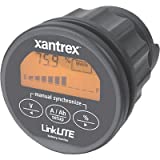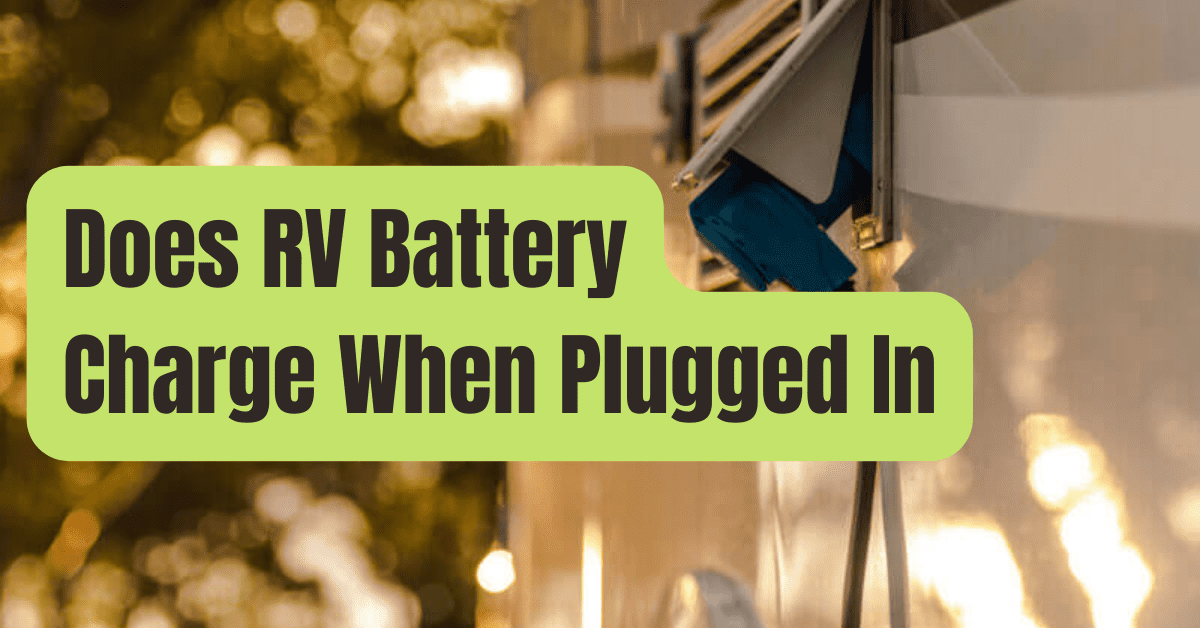There may be an unexpected learning curve when you first move into an RV or take it on a long trip with respect to how electronics and appliances are powered.
It’s critical to comprehend how your RV home batteries function.
It is normal to wonder things like “What does the RV battery truly power?” and “Do RV batteries charge when hooked into shore power.” In an effort to debunk some of the myths around them, we’ll be looking at these issues and more today.
When An RV Is Plugged Into Shore Power, Do The Batteries Charge?
When connected to shore power, your home batteries do actually start to charge.
Your 12-volt accessories, such as interior lighting, water pumps, vent fans, etc., are powered by house batteries.
Additionally, they can power 120V AC appliances.
IF an inverter is a part of your setup.
When you connect into shore power, your chassis battery may or may not be charged if you have a motorized RV (class A, B, or C).
It is also the one that activates the horn, windshield wipers, taillights, headlights, and other driving-related features.
However, not all RVs charge the chassis batteries.
The chassis battery (or batteries, in bigger motorhomes) of your vehicle will only be charged by the alternator while the engine is running if it is not supplied by shore power, which is more typical in smaller vehicles.
It’s critical to safeguard your RV’s electrical system before you hook it into the nearby shore power outlet! In our last piece, we covered RV power cables and provided further details on how to safeguard your vehicle against “poor” shore electricity.
You may look into them or the Hughes items we use to safeguard our RV.
Recognizing The Electrical System In An RV
The electrical system on your rig isn’t very difficult, but if you’re unfamiliar with how it operates, it could appear intimidating.
In essence, the majority of RV appliances are powered by one of two straightforward power sources: 120-Volt alternating current or 12-Volt direct current (120V AC).
DC Power 12V

Anything that works on 12V DC is directly powered by the 12V house battery bank in your RV.
The water pump, inside lighting, and vent fans are all included in this once more.
Your battery bank will be linked in pairs to create 12 volts even if it only has 6 volt batteries.
Even though 24V systems are sometimes used by RVs, it’s doubtful that your vehicle will have one.
Many of the everyday items you use can easily be operated since your home batteries store and provide energy whether or not you are hooked into shore power.
It’s crucial to keep in mind that your 12V DC system generally won’t be able to run all of your appliances, such as your air conditioner, and it also has storage capacity restrictions based on the quantity, kind, and size of your batteries.
This is why having access to shore power, a generator, solar electricity, or when driving is so advantageous for charging your home batteries.
120 Volts AC

The most power-demanding appliances are run by the 120V AC system.
This system powers your microwave, any air conditioners, and 120V domestic outlets.
There are three different ways to get 120V AC electricity in an RV: via shore power, a generator, or an inverter.
Connecting to shore power is the simplest way to provide electricity to a 120V AC system.
Although the smallest RVs may be fitted with a 15-amp plug, exactly like a standard domestic appliance, your vehicle will generally have a 30-amp or 50-amp plug that connects to a matching outlet.
There is still hope if you lack access to shore electricity.
When you’re boondocking or otherwise away from a power pedestal, your 120V AC system may be powered by the onboard generator found in many RVs.
If your rig doesn’t have an onboard generator, you may also buy a portable, standalone generator.
On Shore Power, How Is The RV Battery Charged?
A converter, which transforms AC power into DC power so that your battery charges properly, is used to charge the battery when you connect your boat into shore power.
A suitable externally applied 12V battery charger may also be used to charge your home batteries.
But the majority of RVs feature a built-in converter (also typically known as a converter-charger).
All of these functions are usually combined into one device called as an inverter-charger, which is typically seen in larger RVs that frequently include inverters (which create 120V AC from your 12V DC battery bank).
We’ll save the in-depth investigation of the gadget for another time.
Converter-Charger or RV Converter
The converter in your RV is multifunctional.
It supplies electricity to your appliances AND recharges your home batteries when hooked into shore power.
Although not all RVs are connected in the same manner, the fundamentals are.
Usually, the converter is a component of the power center, which also houses the fuses and breakers for the 12V DC and 120V AC power systems.
The fact that 12V power is supplied to DC devices and 120V electricity is sent to AC ones enables the various power systems to provide the proper current to the proper appliances.
Your home batteries may recharge anytime you are connected to shore power thanks to the converter’s additional function as a charger, which sends 12V DC power to them.
The converter/charger that comes with the majority of RVs nowadays has a balanced, three-stage charging profile to appropriately recharge your battery(ies) so that you may get the maximum life out of them.
Additional Methods for RV Battery Charging
The house batteries in your RV may be charged in a variety of methods, in addition to just tapping into shore power, as was already described.
#1. Use A Generator

A motorhome’s onboard generator is typically connected to an on/off switch within the vehicle’s cabin.
Your onboard converter/charger and other electrical equipment get 120V electricity from your generator.
The converter/charger recharges the energy in your home batteries while the generator is operating, much as shore power would.
You may buy a variety of tiny, portable generators that you can connect your RV into if your RV doesn’t already have one.
In essence, it’s similar to hooking into shore power…
However, you will be restricted in what you can run according to the generator’s output capacity.
In any case, there is more than enough power to recharge your batteries.
The onboard charger will very certainly start charging your battery(ies) straight away (or after a few minutes of “thinking”), refilling the power you’ve used, in either case (onboard or portable generator).
It’s a good idea to be aware of these information to avoid unintentionally overloading your generator: Until you’re certain the generator can handle it (or the charger is getting near to ending its charging cycle), avoid using too many high power-draw gadgets.
#2. By Way Of The Alternator
When you’re traveling down the road, the alternator in many RVs charges both your vehicle’s (chassis) battery and your RV’s (house) battery.
RV manufacturers often use either an echo charger or a bi-directional relay delay (BiRD).
- A BiRD system connects the chassis and home batteries via a high-capacity relay, enabling the house battery to charge from the alternator while the engine is operating (and vice versa when plugged into shore power).
- An echo charger takes a part of the charging current from the chassis battery (when it nears full charge) and delivers it to the house battery bank.
If your RV did not arrive with one, you may add one after the fact (like this unit from Xantrex, available on Amazon).
Both systems are practical, particularly if you travel around a lot.
Just keep in mind that your RV may not be connected in this manner.
When the engine is operating, it may only charge the chassis battery, not both battery banks.
#3. Using Solar Energy

Another popular choice for recharging RV batteries is solar energy.
Solar power has grown to be a very popular add-on for many RVers, including us, even though the majority of RVs don’t come off the lot with pre-installed solar panels (or at least not enough solar for spending any decent time off the grid).
Off-grid camping is changed forever by solar.
As long as there is sun, we can operate with our (admittedly enormous) system nearly as if we were hooked into shore power without having to use our generator.
That’s very amazing considering how much electricity a typical refrigerator uses.
Either install temporary solar panels that you set up in the sun or permanently fix solar panels on the roof of your RV.
Avoid Overly Draining Your Batteries By Using A Battery Monitor.
While not all RVs have, some do include a battery meter.
However, whether you have a single home battery or a bank of many house batteries, this monitor (and we’re not talking about the “idiot lights” that indicate your battery status in 25 percent increments) may be a crucial piece of equipment.
You don’t want to deplete your batteries too low, which is why you should keep an eye on them, particularly flooded lead-acid batteries.
More over 50% of a lead-acid battery’s stated capacity may cause catastrophic damage and drastically shorten the battery’s usable life.
Lithium batteries, however, may be pushed down considerably farther without experiencing any problems.

Xantrex 84-2030-00 LinkLite Battery Monitor
- Think of your battery bank as a gasoline gauge.
- 12.065 inches high by 16.764 inches long by 9.652 inches wide (centimeters)
A battery monitor does exactly what its name suggests: it keeps an eye on your battery and informs you of how much power is left in it so you can avoid depleting it too much (and know that you have enough power to get you through the night).
Conclusion
Understanding the electrical system in your RV involves a variety of factors.
One of the numerous power-related queries an RVer should be ready to answer is “Do RV batteries charge when hooked into shore power?” We hope going over some of the fundamentals in this article has given you a good foundation for learning more about the electrical system in your RV.
And just in case you passed over it (or missed it altogether), Do RV batteries charge when connected into shore power is the answer to the question, is YES! ????










